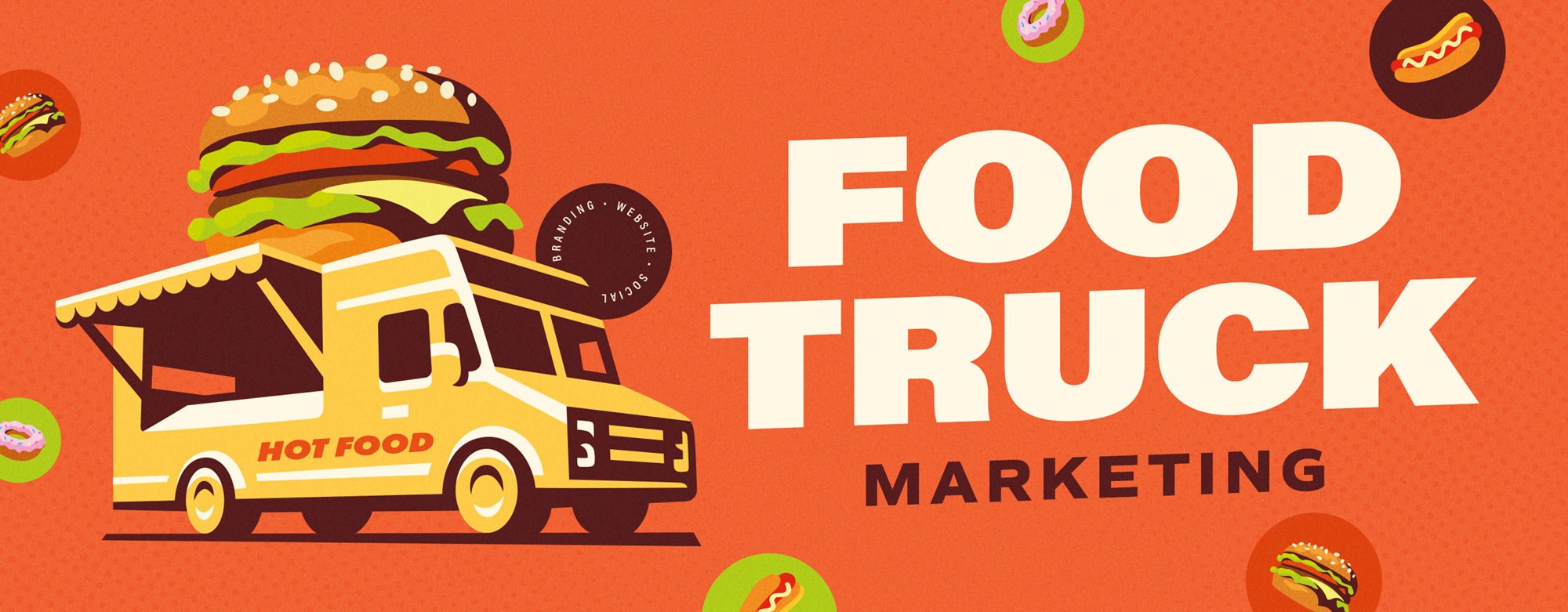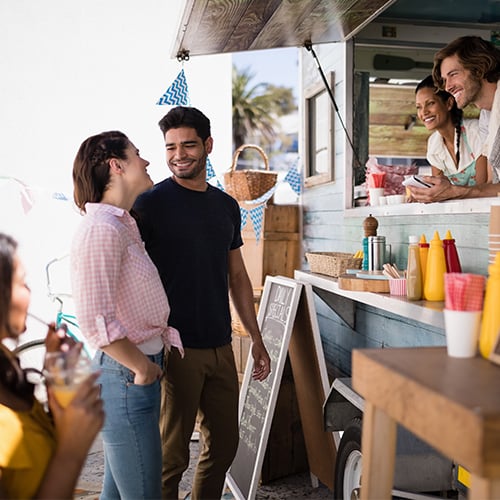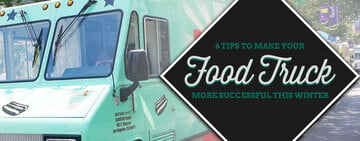
Unlike brick-and-mortar restaurants, repeat customers are a rare commodity for food trucks. Therefore, having a solid marketing strategy in place to attract and engage customers is crucial to the success of your food truck. By combining this strategy with a well-developed business plan, you can effectively connect with your target audience and drive success for your food truck venture. Check out our comprehensive food truck marketing plan, which includes branding, social media marketing, and location strategy.
Food Truck Marketing Plan
A strong marketing presence helps the public recognize and identify with your business. Developing a well-thought-out marketing strategy ensures that your message effectively reaches and resonates with your target audience. Below we list the essential elements of successful food truck marketing:
1. Branding

As the food truck industry becomes increasingly saturated, your branding sets you apart from every other food truck. Create a distinct brand to help ensure your food truck's longevity. A strong food truck brand consists of the following elements:
- Logo: Choose a simple, easy-to-interpret logo.
- Font: While using a creative font can be an effective way to support the overall mood of your business, make sure important information is legible.
- Graphics: Most food truck operators decorate their trucks with eye-catching graphics that entice customers to buy their products. These decorations advertise your business as you drive through town.
- Copy: Names of menu items and the cohesion of your menu selection are part of your brand. Written words also matter in social media posts or articles about your business for print and online publications.
2. Website Development
Every dining establishment needs to develop a website, but your food truck's website has unique needs. Since the food truck target market is only a few decades old, the primary way your customers will discover and interact with your business is online. Use your website to do the following:
- Showcase Your Location Schedule: Because your business has no fixed location, use your website to help customers easily find your food truck.
- Menu: If potential customers are intrigued by your site's images and copy, they'll want to check out your menu to try it for themselves.
- Typical Hours and Locations: While your hours and locations may vary, including customary places you operate lets your fans assess whether you can become a lunch spot staple or if it will require a weekend trip to sample your offerings.
- Mission Statement: Since individuals eat at food trucks to support local entrepreneurs and connect with a community, writing a powerful mission statement and including it on your website is a great way to boost your marketing efforts.
- Images of Your Food: Beautifully lit and tantalizing food photography images will convert people from website visitors to paying customers.

3. Social Media Marketing
This digital age ushered in the reign of social media marketing for creating buzz and promoting businesses. In the food truck sector, social media is not just a way to connect with customers. It is an essential tool for growing your food truck business. Showcase new and favorite menu items, special deals, locations, and swag on social media to continue building a customer base.
Food Truck Social Media Marketing Best Practices
Marketing on social media is tricky due to the various unspoken rules dictating the success of a campaign. Use these social media marketing best practices to ensure your food truck stays relevant on social media platforms.
- Reviews: People will review your food truck and pose questions about your operation on your social media pages. Correctly managing comments and reviews is equally important as the reviews themselves.
- Two-Way Communication: Ask for customer feedback by creating polls on what locations and menu items they like. These posts help generate a steady stream of content and provide invaluable insight into how to run your business.
- Photos: Dabble in food photography by posting images of your daily/weekly specials, new menu items, and best-selling dishes with clever, actionable captions that match your food truck's branding.
- Giveaways: Create engagement by offering free items to winners who follow your account, tag friends in your giveaway post's comments, and share the giveaway on their personal social media pages. You can also partner with other social media pages for more exposure.
- Let Customers Market for You: Reposting and sharing the photos where customers tag your business is an easy way to get attractive images without generating all the content yourself. Make sure to get their consent to repost their photo and tag them to give them credit.
Top Social Media Platforms for Food Trucks
We broke down the top social media platforms for food trucks and how to use them.
- Yelp: Take control of your food truck's Yelp page, encourage customer reviews, include your own high-quality photos, and provide information on price range.
- Facebook: Use your Facebook page to share information, engage with customers, create events, and respond to customer questions.
- Twitter: Keep customers updated on your location and inventory, and share your brand's identity and values through clever tweets.
- Instagram: Utilize Instagram stories to build rapport with customers, share and repost customer photos, collaborate with influencers, and create reels for increased visibility. For an in-depth resource, we also offer a comprehensive Instagram marketing guide.
- TikTok: Share TikTok videos of your staff, meal preparation, catering events, and your food truck setup to showcase your brand and engage with followers.
Back to Top

4. Menu
Your food truck menu is a powerful marketing tool that attracts customers, showcases your culinary offerings, and differentiates your brand from competitors. A well-designed and thoughtfully curated menu entices potential customers, builds brand recognition, and ultimately drives sales. Unique dishes and fun twists on classic meals make your food truck menu stand out in a crowd, so harness your creativity as you build your menu.
Top Selling Food Truck Foods
The most popular food truck foods are handheld items offering a creative twist on classic favorites. Most food truck consumers want takeout and delivery-style meals that they can enjoy without hassle. Examples include Mexican-Asian fusion, vegan reinventions, and organic or gourmet versions of childhood staples. To stand out, incorporate local ingredients, cultural heritage, or a fresh spin on popular items.
Here are a few of the top-selling food truck foods:
- BBQ
- Cupcakes
- Sliders
- Tacos
- Gyros
- Lobster Rolls
- Grilled Cheese
- Popsicles
- Falafel
- Pizza
- Burritos
- Bao
5. Use a Food Truck App
Tech developers have created several applications to assist the over 25,000 food truck businesses operating in the US. Marketing your food truck through a food truck app guarantees that you're directing your message toward potential customers actively seeking a food truck and individuals invested in your local food truck scene. Here are a few of the best food truck apps for marketing your business.
- Roaming Hunger: As the leading food truck app in North America, Europe, and China, food truck owners use this app to broadcast their location and menu to potential customers. You can create an account, share info with locals, and find catering and event opportunities. Customize your page with special offers to attract hungry patrons.
- WTF (Where's The Foodtruck) Vendor App: WTF is a helpful app for food truck vendors in major US cities that shares your location, enables in-app orders, promotes your truck, links to social media and website, and connects you to catering and events.
- Find Your Local Food Truck App: Most major cities have food truck apps specifically designed to catch the attention of their regional clientele. Since building lasting relationships within your local community is a top priority, check into the local food truck apps that will help you become a pillar within your local food truck market.

6. Location Strategy
Whether dealing with real estate or food trucks, location is everything. To choose locations, identify and target the interests of your local customer base. Network with local booking agents and find out what entertainment is coming through town, then strategically park your truck when and where you'll get the most exposure.
Can Your Food Truck Park Anywhere?
No, you cannot park your food truck anywhere you want. Each city offers different guidelines and restrictions. We have an in-depth guide to the best cities for operating a food truck, but every city makes some accommodations for the food truck industry. As long as you uphold your community's guidelines and restrictions, you can achieve some decent business through strategic placement.
Food Truck Location Ideas
Bring your food truck to different parts of town to reach as many new customers as possible and learn what demographics are most interested in your products. Once you know where you're best received, you can join community events where people will love your food. Below are great locations to park your food truck:
- Food Truck Park
- Near a Medical Campus
- Local Farmer's Markets
- Near a College Campus
- Featured Vendor at a Local Event
- Commercial Areas with Few Food Choices
- Near Popular Public Parks
7. Catering
Taking part in the food truck catering sector is like jumpstarting your brand, allowing you to earn a steady income and reach new prospective clients and fans. Events give guests who may never have heard of you an opportunity to try your food, and they’ll likely remember you the next time they see you around town. For instance, food truck-catered weddings are increasingly popular for couples who want to offer a unique experience, cut the cost of an expensive sit-down meal, and encourage mingling.
Food Truck Catering Clientele
Below are a few different types of clientele you can serve with your food truck:
- Weddings
- Corporate Events
- Retirement Parties
- Conferences
- Retreats
- College Campus Events
- Graduation Parties

8. Partnerships
Team up with local businesses, organizations, and other food trucks to grow your audience. While other food trucks are technically your competition, you all have unique things to offer. The support of other food truck owners can go a long way toward securing your success in the business.
Conversely, local businesses and organizations are often happy to establish partnerships with food trucks to keep their customers sated and lingering at their business for hours without returning to their own commercial kitchen operation.
Food Truck Partnership Ideas
Below are ideas of partnerships you can make to grow your food truck:
- Food Truck Rallies
- Breweries
- Outdoor Movie Theaters
- Book Stores
- Sweet and Savory Food Truck Team-Ups
- Farmer's Markets
- Open Air Shopping Centers
- Museums
9. Merchandising
Once you have a dedicated fan base, offering merchandise with your logo encourages your customers to spread the word about your business. Choose merchandise that relates to your type of business. For example, if you operate a BBQ truck, you could sell cast iron trivets. If you have a cupcake truck, branded oven mitts might be appropriate.
Food Truck Merchandise Ideas
While these popular merchandise items may seem cliche, they are inexpensive, handy, and customers can incorporate them into their daily lives. Consider the cost vs. benefits of branded merchandise before diving in. Check out our list of common merchandise ideas you can create to market your food truck:
- T-Shirts
- Koozies
- Stickers
- Travel Mugs
- Keychains
- Lanyards
Back to Top

Who Is the Target Audience for Food Truck Businesses?
As you craft a successful food truck marketing plan, you must understand the target audiences for food truck businesses. Middle-class millennials are the target market of the billion-dollar food truck industry. According to an IBISWorld Inc. report, 43% of food truck spending each month is made by 25- to 44-year-olds, with an additional 20% coming from those under 25.
Why People Eat at Food Trucks
Understanding why people enjoy eating at food trucks is essential for targeting the right customers and developing effective marketing strategies. By considering factors such as convenience, unique menus, supporting the local community, and the social experience, you can create a compelling brand story that resonates with your target audience and drives customers to your food truck. Here are a few reasons why people eat at food trucks.
- Convenience: Food trucks supply quick and delicious food options, particularly for those working in commercial areas with few meal choices.
- Support Small Businesses: Many millennials and Gen Z-ers prefer supporting a local food truck entrepreneur rather than spending their dollars at a chain.
- Exposure to New Cuisines and Flavor Combinations: A food truck's target audience enjoys being able to sample new cuisines and flavorings without committing to a cost-heavy sit-down restaurant entree.
- The Cool Factor: Millennials love participating in the modern food truck craze and sharing photos of their unique food truck meals.
- Community: Customers enjoy dining outdoors with other food truck patrons in parks and creating dining spaces alongside others at events.
Set your mobile business up for success by creating a solid food truck marketing strategy. By having a captivating logo and a well-crafted website, along with a strategic approach to social media and high-quality food photography, you can significantly increase the visibility and impact of your food truck.





